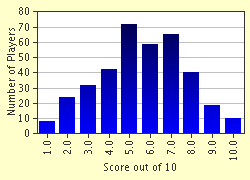Quiz Answer Key and Fun Facts
1. "The Man Who Came to Dinner" was a clever play by George S. Kaufman and Moss Hart; it later became a movie with Monty Woolley (doing a superb job) and Bette Davis. The title character was said to be based on Alexander Woolcott; who was the character of "Banjo" (played by Jimmy Durante in the movie) based on?
2. "On The Waterfront" was said to be a (thinly) disguised comment by the movie's director on the "rightness" of going forward and "naming names" in the days of the Hollywood Blacklist. Who was the director?
3. Arthur Miller wrote a play that was set amidst the hysteria of the New England witch hunts. It is said, however, that he was actually attacking the more recent "witch hunts" of McCarthyism. What was the play?
4. "White Heat" provided James Cagney with one of his best gangster roles. The criminals portrayed in that movie were said to be loosely based on what actual criminal gang?
5. "Citizen Kane," the classic movie by Orson Welles, was said to be based on a man whose claim to fame was in what field?
6. "Youngblood Hawke," a novel by Herman Wouk (and later a movie starring James Franciscus), was said to be based on the life of what famous author?
7. The fictional character of Long John Silver was created by Robert Louis Stevenson and was said to be patterned after what poet?
8. "The Valley of the Dolls" was a popular novel that was turned into a successful movie. Many people tried to guess what famous individuals were being described in the book and movie. Who wrote the novel?
9. "The Lodger" was a fictional portrayal that was loosely based on what famous criminal?
10. "Washington Square" was said to be a work of fiction -- but the author was criticized for his portrayal of a woman who actually lived in the area. Who was the author?
Source: Author
robert362
This quiz was reviewed by FunTrivia editor
DakotaNorth before going online.
Any errors found in FunTrivia content are routinely corrected through our feedback system.


